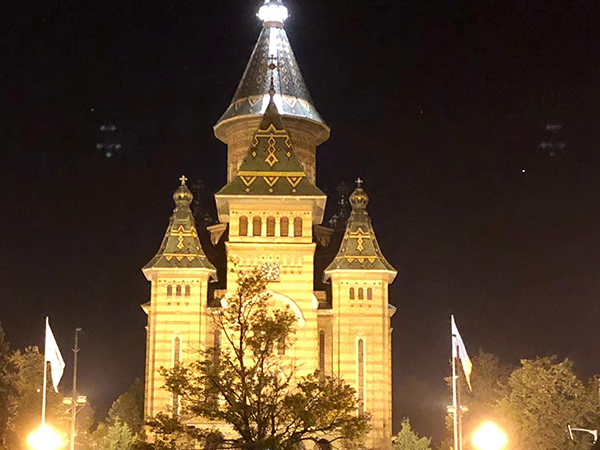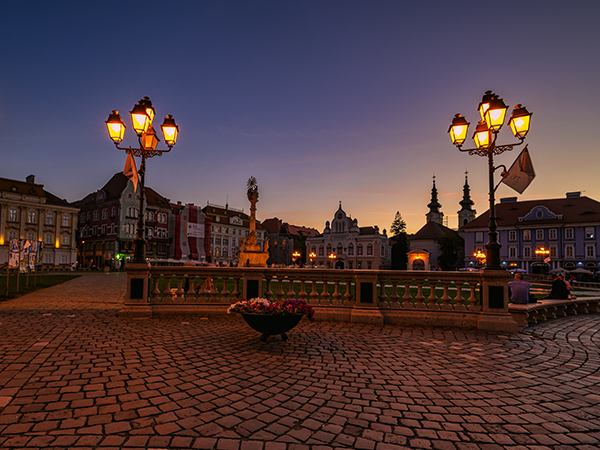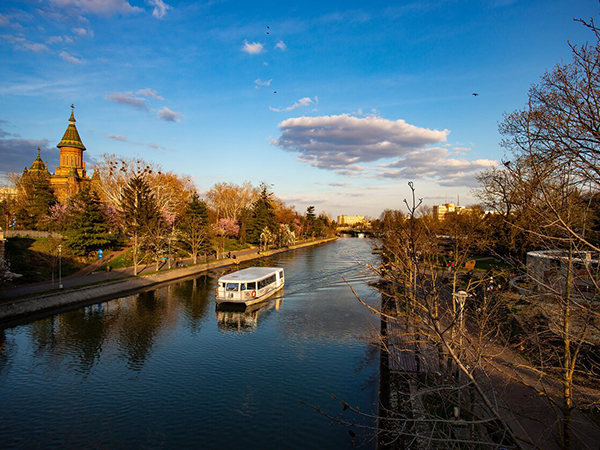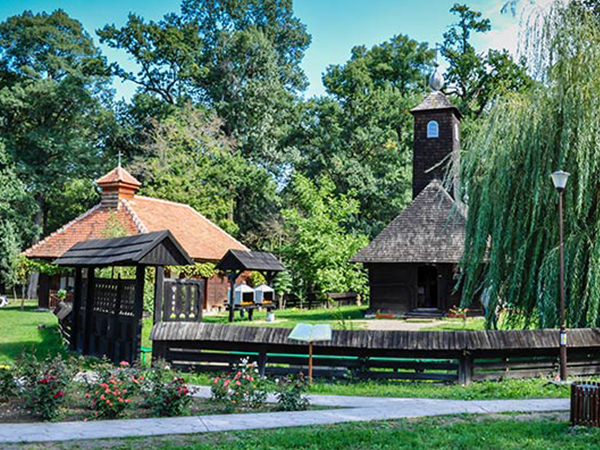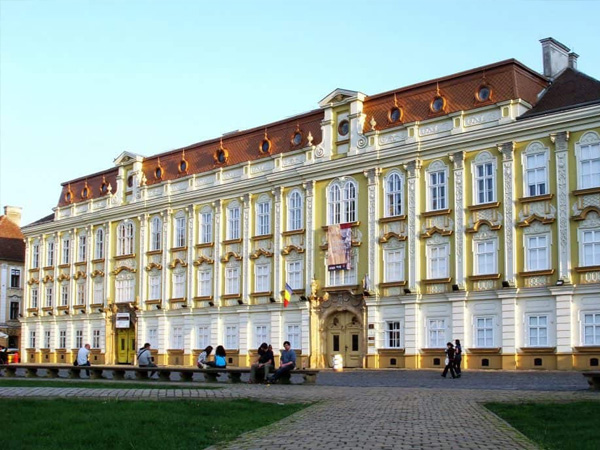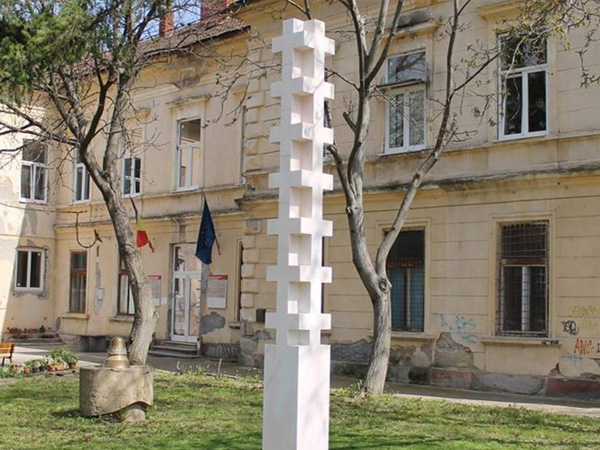About Timisoara

The charm of this city, settled on the northern bank of the Bega River, lies in its distinct architectural character and vibrant cultural life. Frequently referred to as “Little Vienna,” Timisoara is home to year-round musical and theatrical performances, art galleries, museums and a buzzing nightlife. A progressive, cosmopolitan place, Timisoara was the first city in Europe and second in the world after New York, to use electricity to illuminate its public streets.
Timisoara was the first European city to introduce horse-drawn trams (in 1869) and electrical street lighting (in 1889).
Timișoara’s architecture is the first thing that stands out when it comes to the city’s rich cultural heritage:
Timișoara Metropolitan Cathedral
The Timișoara Metropolitan Cathedral is one of the most imposing buildings, tall at 80 meters, with 11 towers, and seven bells. Its cupola is built in Moldavian style, while the side arches are in Byzantine style and the mosaic floors recreate motifs found in Banat style rugs.
Catholic Dome
The Catholic Dome is the most important Baroque monument in the Banat region. Its sumptuous interior features nine altars decorated in rococo style, made by Viennese painters and sculptors.
Victoria Square
Victoria Square, the newest of the Cetate district squares, is where on December 20, 1989, Timişoara was proclaimed the first free city in Romania, marking the beginning of victory in the revolution against the communist dictatorship.
Unirii Square
The Unirii Square, with its Baroque expression, is undoubtedly one of the most beautiful squares of the city, dominated by the Catholic Cathedral and Serbian Orthodox Cathedral placed opposite to each other. Besides the two churches that dominate the square, there is also the Baroque Palace, and is now the headquarter of the art museum of Timisoara. Unirii Square is a whole of architecture that reflects in the best way the open and tolerant spirit of Timisoara.
National Opera House
The National Opera House from Timisoara, Romania is a cultural public institution, his activity being held on annual artistic seasons, performing opera, operetta, ballet and opera for children performances, at home as well abroad. The National Opera House from Timisoara was establishing through Royal Decree no. 254/31st of March, 1946.
Timișoreana brewery
The Timișoreana brewery is the first brewery established on the current territory of Romania. Next to the factory there is a restaurant where you can drink fresh factory products.
Banat Village Museum
In the north-east of the city, not far from the road leading to the airport, is Padure Verde-The Green Forest.
On the outskirts of the forest, on a 17 hectares area, lies the Banat Village Museum. Its foundation is due to persistence of Ioachim Miloia, an important cultural personality of the interwar Banat. The Transylvanian poet Lucian Blaga noted admiringly that “Banat is the Romanian ethnography Baroque”. The richness and diversity of rural civilization in the region had been noted ever since the eighteenth century by Western travelers. The collection of olden households and popular technique installations tries to objectively present the reasons for such assessments.
Banat Museum
The Banat Museum occupies the entire space offered by Huniade Castle – the oldest documented building in Timişoara. It was built by King Charles Robert of Anjou between 1307 and 1315 as a royal residence, also having military functions. It was later expanded under Iancu de Hunedoara, but was also damaged during the many sieges (1552, 1716, 1849). It acquired its contemporary appearance after the 1856 reconstruction, and since 1948 the castle houses the Banat Museum collections. Following the archaeological research conducted in 2009, in the courtyard there were discovered the foundations of the first donjon tower of the medieval castle, together with a still functional well. It was also established that this tower was built on the foundation of an even older building. The courtyard also preserves a lapidarium collection, with ancient and medieval works.
Timisoara Art Museum
The Museum is hosted by the Baroque Palace, one of Timişoara’s key buildings, built in Baroque style in the second half of the eighteenth century in the city’s Main Square (now Unirii Square). The exterior decorative motifs betray a close Viennese lineage, being remarkable similar to Kinsky Palace.
The history of the art collection is directly intertwined with the beginnings of the Banat Museum, founded in 1872. The heritage was established in the second half of the nineteenth century, when Ormós Zsigmond, a collector and art historian, donated his entire collection to the community. Supplemented by acquisitions and donations, nowadays the heritage comprises more than 8,000 objects: painting, sculpture, decorative art and graphics.
National Theater ”Mihai Eminescu”
The National Theater, which delight since 1946, through the rich repertoire and the important names that played on its stage, has become an important place in the local cultural life. The building of the theater was built between 1872 and 1875 in the style of the Italian Renaissance by the architects Helmer and Fellner of Vienna. Every year the Timişoara National Theater brings a great challenge, both cultural and social, through the festivals it organizes. The Romanian Dramaturgy Festival is hosted annually by the National Theater of Timişoara.
1989 Revolution Memorial Museum
The Museum of the Romanian Revolution from 1989 in Timişoara is the most important point of storage and presentation of information on the December 1989 Revolution from the entire country.
In this space, the “December 16-22, 1989 Revolution Memorial” Association collects written, audio and video information on the bloody events, some of the material being exposed for visiting. The exhibitions cover life under the communist dictator Ceauşescu, but also course of the revolution in Timişoara, which ultimately led to the regime’s overthrowing. You can watch movies that present the drama of those days.
You can find more information about Timisoara on the website of the Romania Official Travel and Tourism Information Center.
Early bird
registration
Deadline abstract
submission
Abstract acceptance
notification
3 Victor Babes street, ap. 3
Cluj-Napoca, Romania
+40 364 146 681
esbra@medevents.ro


